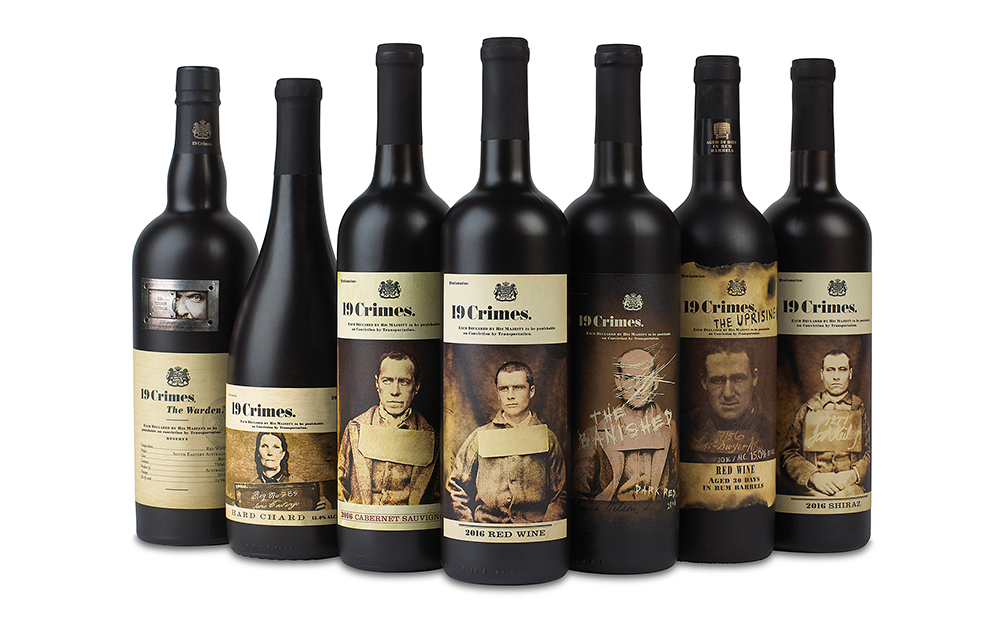
BY RICK RIOZZA
So the language goes, “Nineteen crimes turned criminals into colonists.” Upon conviction British rogues guilty of a least one of the 19 crimes were sentenced to live in Australia, rather than death. This punishment by “transportation” began in 1783 and many of the lawless died at sea. For the rough-hewn prisoners who made it to shore, a new world awaited.
“As pioneers in a frontier Australian penal colony, they forged a new country and new lives, brick by brick.” The 19 Crimes wine portfolio on sale throughout America is, deemed by marketers, as the wine that, “celebrates the rules they broke and the culture they built.”
We all like that type of anti-hero convict that ultimately achieves a certain justice in the long run. Twenty years ago or so, we were finally told that our own country was incarcerating more people than the Soviet Union! Over 2 million!—and so many for “drug crimes” promulgated in the 1980s.
So—I guess that’s why wine labels that highlight or celebrate “crimes” and that type of drama will always grab our attention. For the wine crowd here in the desert, most of us have indeed seen the 19 Crimes wine labels here & there at all of our wine stores and now showing up on our restaurant menus. For the price, these wines work and are quite tasty.
The Australian wine business is pretty interesting stuff for us California wine lovers. We’re all in when it comes to talking about wine country history, characters, and promises, and so many of us have been spectators to both the comings & goings and the histrionics surrounding both California and Australia wine lore.
A couple of months ago, we conducted a wine seminar at the Education Center located in the Palm Desert Total Wine Store, for which I titled, “Fun Down Under!—Southern Hemisphere Wine Country”. We had a lively group of predominant California Cabernet Sauvignon lovers in the audience, and although most were not really up on Australian wine lately, they did know that they could (1) still get a bottle of Yellow Tail wine for less than four bucks a bottle, and, (2) that they know of, have full respect for and even lust after the famous Penfolds Grange, Australia’s most revered red wine.
Just as with the Robert Mondavi-types of winemakers in California who knew they could produce a wine as fine as the best Bordeaux from France, in Australia, another young winemaker, Max Schubert, fresh from visiting the vineyards all along the banks of Bordeaux and along the Rhone Valley came back home to Southern Australian and informed the wine firm to which he was employed—Penfolds, that “we” can produce a world class wine as well.
Back in the early 1950s, Penfolds and other wine companies were doing fine making heady fortified wine to satisfy the nation’s desire for strong drink. But soon there was fervor in the air all around the world where “new world wine” would strive through craft, science, and innovation to be the best.
Schubert saw the current plantings of Cabernet Sauvignon and Merlot in California and was encouraged by his Australian peers to do the same—which seemed to be the correct advice. But he made a deliberate decision not to make his new wine with Cab, Merlot, or any Bordeaux varietal; he opted instead to use the best red grape then available down-under—Shriaz (the local name for Syrah, originally from the Rhone Valley in France). And do we Californians know the plumpness of Syrah—or what!
Combining traditional Australian techniques, inspiration from Europe and precision winemaking practices developed at Penfolds, Schubert made his first experimental wine in 1951. He called it Grange, for the name of one of vineyards he sourced from, and added “Hermitage” for both a nod to the area in France famous for their Syrah, and, to throw in a French sounding name—why not? (“Hermitage” was dropped in 1990)
To his horror the Grange experiment was universally disliked—“too dry! too rustic! And too intense!”—and Schubert was ordered to shut down the project. What might have been enough to bury Grange in another winemaker’s hands, only made Max more determined to succeed.
Fortunately, the 1955 Hermitage Grange had made its way to the European vino cognoscenti and thereafter to the major wine competitions, winning its way all along to become one of the most celebrated wine in history. Today, the newly released 2013 Grange sells for just over $700 a bottle, garnered a 99 point score, with a peak drinking period recommendation from 2020 to 2060. Anyone in town opening that bottle a little early—just for a glimpse, give me a call!
And now, with that little que Syrah, Syrah background, let’s appreciate the 19 Crimes—Syrah driven wines, even bit more:
The Banished 2016 ($11.99): The Shiraz-dominant blend presents dark red shrouded by purple hues. A nose of blackberry and plum is balanced by notes of dark chocolate, vanilla, clove and cinnamon making this full, plush wine a perfect choice for fall.
Red Wine 2015 ($12): This bold red blend offers vanilla aromas balanced by with riper red to dark berry fruits that rise in defiance from the glass. Vanilla aromatics carry through on the palate and complement subtle favors of chocolate and a cedar-y spice. The palate finishes soft, fruity, and so fresh, it should be a crime.
Hard Chard 2016 ($10): New to market this fall, 19 Crimes’ first white wine also depicts the brand’s first female convict, Jane Castings. Bold and strong in character, this deep, rich and golden Chardonnay is filled with stone fruit aromas and a textured palate.
For you App fans, the newly-launched 19 Crimes Augmented Reality App. the first ever from a wine brand, celebrates the convicts-turned-colonists depicted on the mugshots on its bottle labels, giving them a voice to tell their own stories. Cheers Mate!











































